Hardwood Flooring Finishes, Colors and More
As far as hardwood flooring is concerned, there are many different colors, finishes, styles, and installation patterns to choose from. The hardwood installed in a home or business can be as unique as the people living or working in it. Once the decision to use hardwood has been made, choosing the hardwood flooring finish, color, gloss level, the size of the boards, and the installation patterns must become a priority before the flooring can be bought and installed.

Considering Hardwood Flooring Finishes
Color Choices
One of the things that makes hardwood such an excellent choice is the various available colors. No matter what decor is going in the home or business, there is a hardwood to go with it.
Natural
A hardwood floor can be sealed with a protective clear finish that showcases the natural appearance of the wood. The unique grain pattern and characteristics of the species clearly shows with a natural finish. Some species such as Maple, Pine, and Red Oak have a very light color. Others, such as Brazilian Teak, and Wenge, have a very dark color, and other species will fall somewhere in between.
Almost all exotic species are sealed with a natural finish. In some cases, they are sealed with a lightly tinted finish to accentuate the natural beauty of the wood.
Stained
An almost endless number of looks can be created through the application of a colored stain to hardwood floor planks. It is not uncommon for a manufacturer to use several different species with a variety of stain options to create a spectrum of color choices for buyers.
Light, Medium, & Dark
Some sellers will categorize their flooring finishes in terms of light, medium, and dark, or by color family such as yellows, golds, tans, browns, blacks. If natural and stained categories are not available, it is likely the dealer uses this designation to help buyers find the exact color they want.
The best way to ensure you are getting the right color, be it natural or stained, is to obtain samples of the flooring from the seller. These can be taken to the project site to get a better sense of which color best fits your project.
Light Sensitivity
It is important to note that because wood is a natural product, it can be sensitive to light and darken over time. Some species are more photosensitive than others. The following species are considered to be sensitive to light:
- American Cherry (aka Black Cherry)
- Australian Cypress
- Bloodwood (aka Muirapiranga)
- Brazilian Cherry (aka Jatoba)
- Brazilian Mesquite (aka Andiroba; Royal Mahogany)
- Brazilian Redwood (aka Massanarduba)
- Brazilian Teak (aka Cumaru)
- Brazilian Walnut (aka Ipe)
- Indian Rosewood (aka Sonokeling)
- Kempas
- Nyatoh
- Santos Mahogany (aka Cabreuva)
- Sucupira, dark
- Teak
- Tiete Rosewood (aka Patagonian Cherry)
- Tigerwood
- Walnut
Hickory and maple are both mildly light sensitive.
If you decide on a light sensitive species then it will be important to move furniture and rugs on a regular basis for the first year to allow an equal light pattern reaches the floor. If a part of the floor is covered and the area under the covering appears lighter then remove the covering to allow the floor to equalize. It may take a few months for the covered area to darken to an equal color as rest of the flooring.
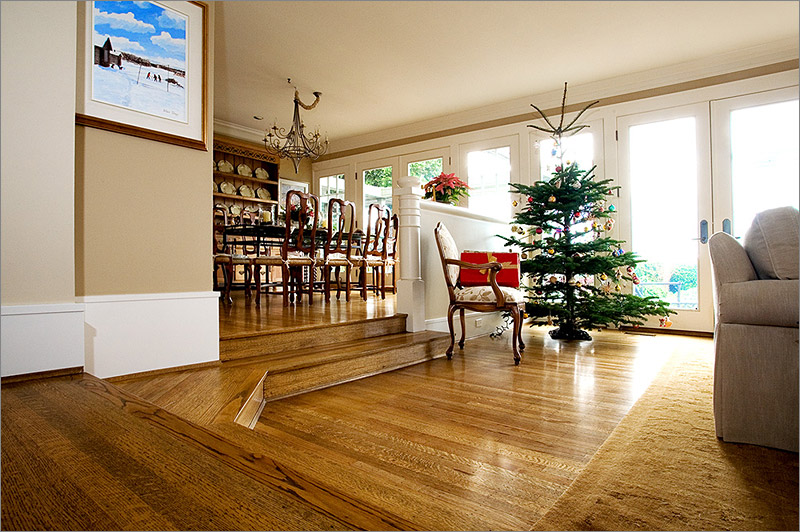
Hardwood Flooring Finish Options
There are a couple different finishing options available which play a role in how the floors should be cleaned and maintained. Surface finishes are easily cleaned with soap and water, while penetrating finishes, sometimes also called penetrating seals, cannot ever be cleaned with water. If a lacquer, shellac, or varnish is used to finish the floor, though it is technically a surface finish, floors must be treated as penetrated.
Surface Finishes
Surface finishes are among the most commonly used finish on hardwood floors today. Nearly all hardwood floors have surface finishes. Surface finishes shield floors from harm by forming a protective layer on top of the wood, making it possible to use a soap and water solution to clean the floors. These finishes will make it look like there is a shiny layer of plastic on the floor. Options include:
- Polyurethane: Polyurethane wood floor finishes are highly resistant to moisture, and can handle spills while resisting stain. They are less likely to show wear and tear over time if properly maintained. These can be used as a high gloss or matte finish, and are either moisture cured or oil modified. This flexibility and durability makes it the most popular floor finish on the market today.
- Urethane: Urethane wood floor finish is available as either a Swedish finish (or acid cure) or water-based. The Swedish finish should only be used by experienced professionals because of the high level of chemicals and odor it produces. People doing their own installation should use water based to avoid the chemicals, but beware of the fast drying time.
- Aluminum Oxide: Factory-finished or pre-finished floors often have one or more coats of finish that include aluminum oxide, second in hardness to diamonds. Aluminum oxide offers durability and a long lasting finish.
- Epoxy: Made of polymers, epoxy sealant is a strong and durable flooring finish. A skilled professional must be hired to apply this finish as it depends on proper mixing and application for best results.
Penetrating Finishes or Seals
Penetrating finishes are those that sink down into the wood, rather than resting on top of it. They protect the wood from within. Water cannot be used to clean floors using this type of finish, so this is a major reason why it is becoming less common. These finishes will make it easy to feel the wood grain if the floor is touched. Options include:
- Oils & Wax: Oil and Wax are two of the oldest and simplest ways to finish a floor. It gives the hardwood flooring protection to prevent dirt from getting into the floors and a nice shine.
- Varnish: Varnish is not as common of a finish as it used to be. It scratches easily so it will show wear and tear sooner than other finishes, but can be found in both high and low gloss finishes.
- Shellac and Lacquer: Shellac is a hard resin that comes from Lac, a substance secreted by insects to make cocoons. It is also used in the food industry to protect food and add shine. Lacquer is a synthetic coating made using cellulose. Both finishes dry quickly, but because they are not as resistant to spills and stains as other finishing options, they are not commonly used now.
How to Figure Out the Finish
When it comes to cleaning and maintenance of the floor, knowing the finish is essential. Ask the realtor who helped in the purchase of the home or try one of these tests to determine what kind of finish is likely on the wood floors in the home:
- Put a small amount of water on the floor and leave it sitting for about 10 minutes. If there’s a water spot, it is likely a polish or wax based finish. If not, it’s a surface sealed floor.
- Run a finger across the floor. If there’s a smudge mark left behind, it’s a polish or wax based finish.
Oil Based vs Water Based Finishes
There are many different oil based and water based options available, though it is important to know the differences between the two. Due to rising health and environmental concerns, the use of oil based finishes is declining in favor of water based.
If the finishes are acid or moisture cured, they are oil based. This is not to say these finishes do not have a place in the industry, as they do cure hard enough to offer great protection and beauty to the floor, enhancing the grain and offering a warm tinted appearance as it ages. The fumes may linger for a week or more, as it takes three to seven days for the finish to completely cure, causing those with allergy sensitivities to suffer.
Water based finishes are much better for the environment and for those who suffer from allergies. They do not darken over time, and when combined with a hardener additive, are harder than oil based finishes. They will however, raise the grain of the floor making it rough, unless they are used after the floor has been treated with an alcohol based sealer. Water based finishes work well and consistently for all three sheen levels. The coats dry fast – usually within an hour – without harsh fumes.
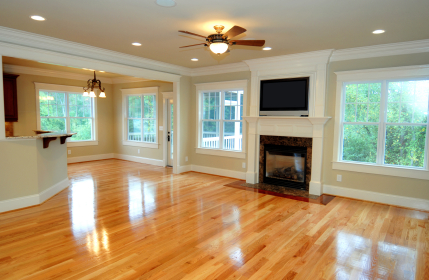
Gloss Level
The gloss level on a hardwood floor refers to the amount of sheen visible on it. How shiny the floor is will have nothing to do with its durability, so it comes down to a matter of personal preference. An important thing to consider is that different wood species will display gloss levels differently. For example, a high sheen on one type of wood may not look the same as a high sheen on another due to fundamental differences in the wood.
High
This type of gloss will be extremely shiny and will reflect more light than other types of gloss. This will lead to a high glare, but will provide the most polished look. Finishes will be labeled with their gloss level. High gloss levels will also show dust more easily than a low gloss sheen will. These are commonly seen in gymnasiums and other commercial settings.
Semi Gloss
Also known as medium gloss, this level is somewhere between the high gloss and the low gloss, providing a relative compromise for those who cannot decide between the two.
Low Gloss: Satin or Matte or Low Luster
Lower gloss finishes will help to reduce the appearance of minor scratches, while a high gloss will accentuate them. This finish level is commonly chosen for professionally site finished floors and for prefinished floors.
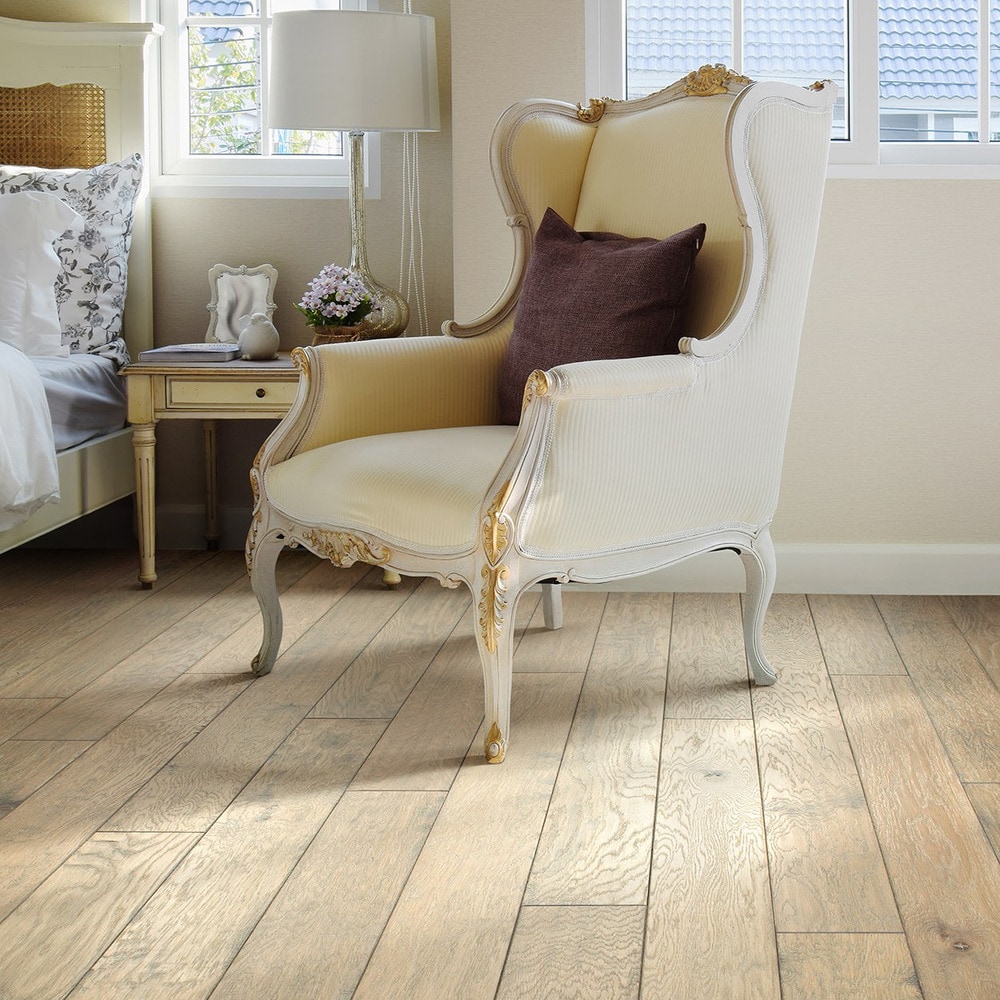
Hardwood Flooring Width
There are a few different width options that will determine the appearance and installation requirements of the flooring. Learning about the width options will help in determining which style of hardwood floor to use.
Strip
This is a linear type of wood flooring in thin width boards, usually around 2 1/4″ wide. The thinner strips of wood are used to create the illusion of space in a room and are recommended for smaller rooms that need to be “opened up” a bit.
Plank
This is a linear type of wood flooring in thicker width boards than strip. Generally, plank boards are anywhere from 3 inches to 6 inches wide. Plank can also come in “wide board” where the widths are typically 5 inches or wider.
Random Width
Some hardwood floors are sold as random width, meaning each box of flooring contains a variety of widths. Some buyers prefer the look that is created by a random width floor.
Parquet
This type of wood flooring is used to create any number of geometric patterns on the floor when it is installed. Each parquet will detail the pattern it is meant to create when it is purchased. A wide variety of parquet floors are available, but will cost more to install because they are more time consuming.
Hardwood Flooring Length
Lengths will vary from manufacturer to manufacturer. Some will include boards of all one length, generally at a higher cost because of the quality required. Others will include boards of random length, while indicating the shortest board and the longest board lengths on the box. With random board lengths, all the boards in the box will fall in between those two lengths. Some manufacturers may even note the proportion of each board length.
The boards are staggered in installation, so to the average eye, one length boards may appear as random length. One length boards will not be uniform in appearance because they will need to be installed randomly, cut to fit the dimensions of the room.
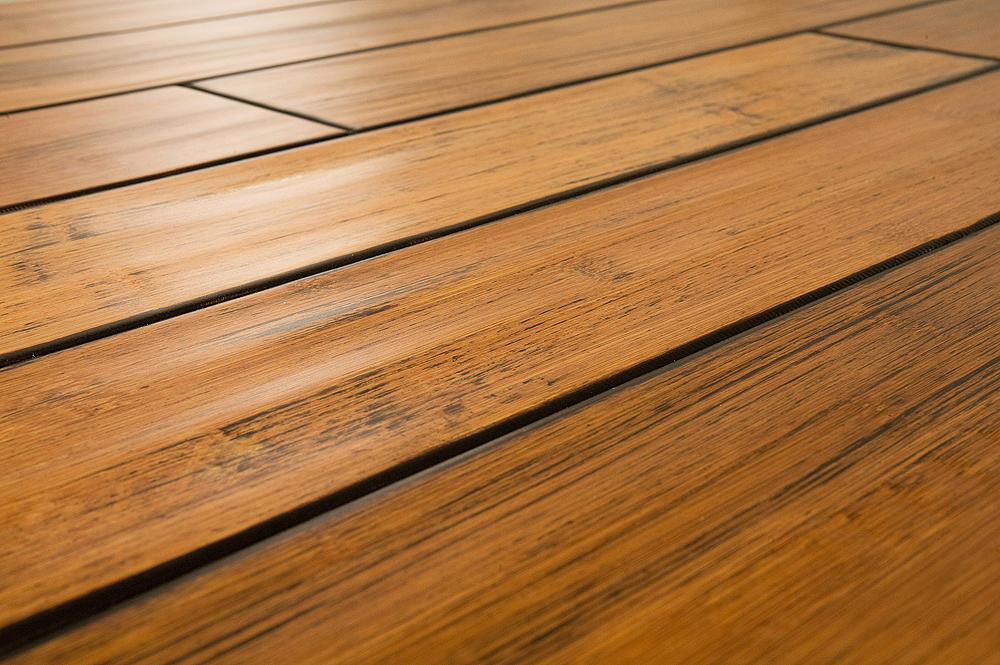
Edge Detail Types
There are several different edge types available which will affect the installation and appearance of the overall floor when the installation is complete. Learning about each one of these edge types will help in deciding which one to use.
- Square Edge: Boards with this edge meet uniformly to create an even appearance blending the floor from board to board.
- Micro Bevel: Boards have an extremely shallow groove, designed to help hide irregularities in the flooring such as uneven board height. It is hard to see a difference between micro and micron bevel.
- Micron Bevel: Boards have an even smaller groove than the micro bevel. Since it is so small, it is hard to tell the difference between the bevel from manufacturer to manufacturer. It also meant to hide irregularities in the floor.
- Eased Edge: These boards have a slightly less distinctive groove in them than the full bevel. There are some manufacturers that add the edge to the end joints as well as the length of the board, which creates a different visual effect when the floor is complete.
- Full Bevel: These boards have a distinctive groove in them, which creates an informal look. The area between the boards is sealed when the floor is finished to make it easier to clean between the boards.
- French Bleed Edge: These boards are distressed and the edges are stained with a dark or black color to make them stand out.
- Pillowed Edge: These boards have a soft and smooth edge.
Installation Patterns
There are two different installation patterns to use when installing a hardwood floor. Each installation pattern will provide different visual interest adding an element of decor to the room.
Plank Style
In this style, the planks – or strips – are laid end to end. Most hardwood floors are installed like this. With this style, boards can be the same width, or random widths can be used.
Parquet Style
In this style, the planks or strips are installed to create a specific geometric pattern. There are several different patterns available to choose from. The parquet pattern gives a very distinct and sophisticated look to a room. Traditional parquet installation is expensive and rare, since it has been replaced with veneer patterns.
Herringbone
In a herringbone pattern, the hardwood floor strips of are laid in a diagonal pattern that looks like a twilled fabric. To develop this pattern, installers can lay it out manually or use pre-made squares, like parquet.
- Brick Pattern Half Bond: This kind of floor is laid down to look like bricks.
- Diagonal Basket: This kind of floor is laid in diagonal squares, with each square containing three boards.
- Square Basket: This kind of floor is similar to the diagonal basket, except it is laid in a linear pattern, rather than diagonal. One square is laid horizontally, and the next is laid vertically to create visual interest.
- Square/Diagonal Herringbone: This pattern is laid in a diagonal zigzag, usually parallel with the walls.
- Single Herringbone: The boards are laid in an “M” shaped pattern, with one board per angle.
- Double Herringbone: The boards are laid in a “W” shaped pattern, with two boards per angle.
- Chevron: The boards are laid in a “V” shaped pattern, using one board per “V” shape.
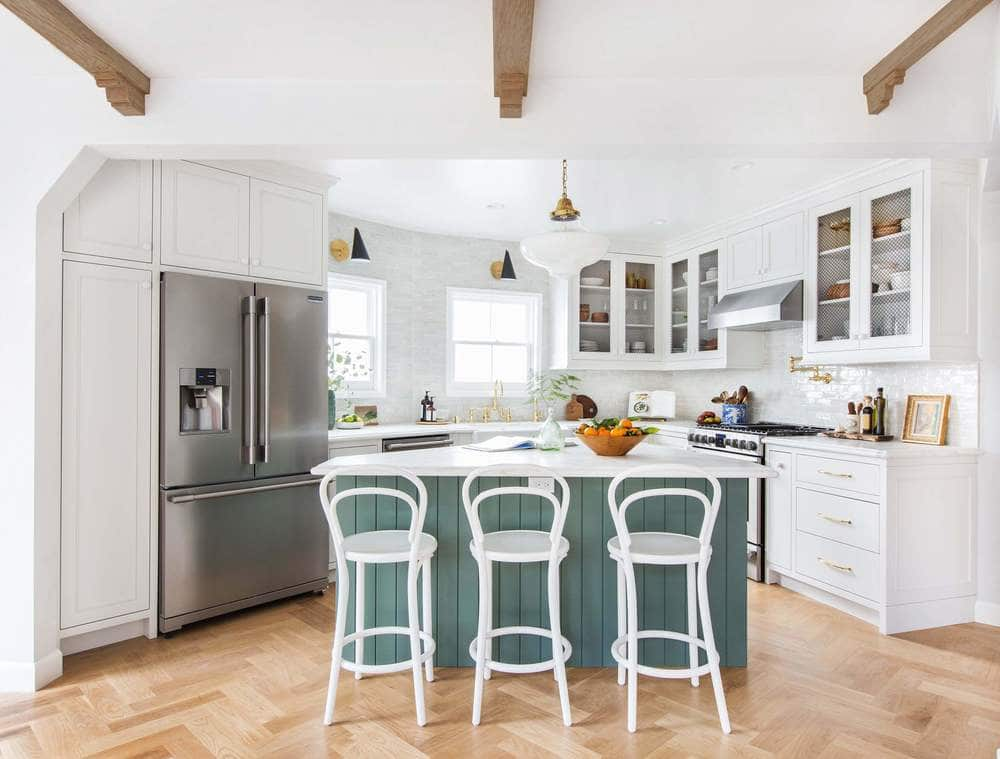
Medallions & Borders
Using medallions and borders will not only add value to a home, but will provide owners with the satisfaction of knowing they have something different from others.
Medallions
These are generally large circular designs placed in the center of a room. Common designs include: a compass, a sundial, a sunburst, or a mandala. Custom designs may include a family crest, monogram, or animal such as a lion.
Borders
These are similar to borders for wall paper, except they are laid around the hardwood floor. They can be anything from a simple dark line, to a more complex geometric pattern. These can be installed at any point throughout the flooring, but are generally installed toward the walls or the center of the room.
Both medallions and borders are considered inlays, as inlays are designs or patterns that are to be “inlaid” into a hardwood floor installation. Before computers could assist in the creation of these materials, they were handmade, making them expensive and rare.


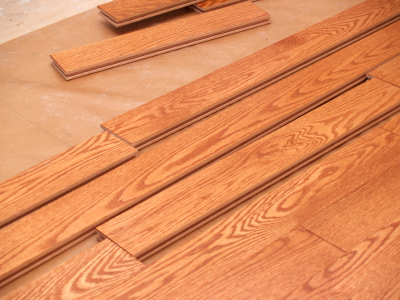

Dan Schaffer
Great article about hardwood flooring, very detailed. Glad I stumbled this article.
Joanne
I just had my floors done. I love the high gloss finished but was wondering can the strains of dust and hair underneath the polyurethane be buffed out. I can see the strands as the floor is drying. Is there another step that should happen?
Susan Abitz
This information is very helpful. My only wish is that there would be photos of what types of finishes and colors, etc. are available. The descriptions are good, but since I am not really familiar with wood flooring, the actual photos of what is being described would be a big help!
Rob Jones
Thanks for the feedback, Susan! A re-design (plus new pictures) is in the offing. Watch this space!
jean
My base is concrete..
jean
I put maple engineered floor in my living room. It is out of the way and gets little traffic. This wood is gorgeous but soft.It is Maple from Canada and a good quality,
I want to do hardwood in my family room that is almost adjoining, ; a wall separates the rooms.. I want it to match somewhat since you can see both floors from the entry and dining room… Is there a type of engineered wood I should use on a floor that gets a lot of traffic? We live in this family room and I will be getting a rug of some sort but– the floor will get constant traffic from the kitchen. (I’m giving up on recarpeting because of the traffic pattern beating the carpet up) What should I use.? thanks..
Don Teets
Hello Gary,
I just finished reading your article concerning colors finishes and more on hard wood floors.
I just wanted to say “Thank you” . This is a great piece,and very informative.
we are still trying to come up with color and a distressed look.
Do all engineered hardwood floor installations require glued joints,and will installing on a concrete
basement floor be OK?
Don
Framcis X. Nolan
How is the length of each hardwood board determined when the pattern to be installed is a Chevron Herringbone pattern? What determines what length will be used?
Gary Sandur
Hi Francis,
From what I have ready the sizes of the boards can range anywhere from 1 1/2ft to 2 1/4 ft in length. The length is determined by the manufacturer if it is sold as a Herringbone pattern. If you are using a regular hardwood and are cutting the pieces to make the pattern, I would then consult with your installer, and or have a look on google and YouTube. Here is a link to the artical I found that maybe helpful.
//www.hardwoodinstaller.com/hardwoodinstaller/herringbone.htm
Pingback: Floors Before and After « Crestwood Cottage
Pingback: Hardwood Flooring Grades: That’s the Look of Love! | BuildDirect Blog